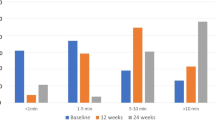Abstract
OBJECTIVE: Two different techniques have been developed to stimulate the gracilis muscle when it is used in anal neosphincter reconstruction. These are direct neural stimulation and intramuscular electrode stimulation. The aim of this study was to compare these techniques. METHODS: Comparison was made of gracilis anal neosphincter reconstruction using neural stimulation (Royal London Hospital in the United Kingdom) with the intramuscular muscular method (University Hospital Maastricht in the Netherlands). The United Kingdom data were obtained from a retrospective database, whereas the Netherlands data were gathered prospectively. RESULTS: A successful outcome was achieved in 46 of 81 patients (57 percent) in London and 148 of 200 cases (74 percent) in the Maastricht study (chisquared=7.2;P<0.01). There was no significant difference between the two techniques in voltage required for stimulation of the neosphincter muscle during a ten-year period. Reoperative surgery for electrode failure or dislocation was required in 21 (26 percent) patients in the London study, whereas only four (2.7 percent) of the Maastricht cases required such procedures (chi-squared=37.8;P<0.05). The high electrode plate failure rate in the London study was related to the source of manufacture. CONCLUSIONS: Both neural and intramuscular nerve techniques provide effective long-term stimulation of the gracilis anal neosphincter.
Similar content being viewed by others
References
Williams NS, Patel J, George BD, Hallan RI, Watkins ES. Development of an electrically stimulated neoanal sphincter. Lancet 1991;338:1166–9.
Baeten CG, Konsten J, Spaans F,et al. Dynamic graciloplasty for treatment of faecal incontinence. Lancet 1991;338:1163–5.
Konsten J, Baeten CG, Havenith MG, Soeters PB. Morphology of dynamic graciloplasty compared with the anal sphincter. Dis Colon Rectum 1993;36:559–63.
George BD, Williams NS, Patel J, Swash M, Watkins ES. Physiological and histochemical adaptation of the electrically stimulated gracilis muscle to neoanal sphincter function. Br J Surg 1993;80:1342–6.
Williams NS. Faecal incontinence In: Keighley MR, Williams NS, eds. Surgery of the anus, rectum and colon. 1st ed. London: WB Saunders, 1993:516–609.
Konsten J, Baeten CG, Spaans F, Havenith MG, Soeters PB. Follow-up of anal dynamic graciloplasty for fecal continence. World J Surg 1993;17:404–9.
Rius J, Nessim A, Gilliland R,et al. Stimulated graciloplasty: main trunk stimulation failures. Changing to intramuscular stimulation: a feasible option. Tech Coloproctol 1998;2:109–11.
Mavrantonis C, Wexner SD. Stimulated graciloplasty for treatment of intractable fecal incontinence: critical influence of the method of stimulation. Dis Colon Rectum 1999;42:497–504.
Korsgen S, Keighley MR. Stimulated gracilis neosphincter—not as good as previously thought: report of four cases. Dis Colon Rectum 1995;38:1331–3.
Christiansen J, Rasmussen OØ, Lindorff-Larsen K. Dynamic graciloplasty for severe anal incontinence. Br J Surg 1998;85:88–91.
Sielezneff I, Malouf AJ, Bartolo DC, Pryde A, Douglas S. Dynamic graciloplasty in the treatment of patients with faecal incontinence. Br J Surg 1999;86:61–5.
Madoff RD, Rosen HR, Baeten CG,et al. Safety and efficacy of dynamic muscle plasty for anal incontinence: lessons from a prospective, multicenter trial. Gastroenterology 1999;116:549–56.
Baeten CG, Spaans F, Fluks A. An implanted neuromuscular stimulator for fecal incontinence following previously implanted gracilis muscle: report of a case. Dis Colon Rectum 1988;31:134–7.
Glantz SA. Primer of biostatistics. 3rd ed. New York: McGraw Hill, 1992.
Geerdes BP, Heineman E, Konsten J, Soeters PB, Baeten CG. Dynamic graciloplasty: complications and management. Dis Colon Rectum 1996;39:912–7.
Baeten CG, Geerdes BP, Adang EM,et al. Anal dynamic graciloplasty in the treatment of intractable fecal incontinence. N Engl J Med 1995;332:1600–5.
Geerdes BP, Heineman E, Freling G, Keizer HA, Woloszko J, Baeten CG. Vascular and stimulation delays in dynamic musculoplasty. Surgery 1997;121:402–10.
Hughes SF, Williams NS. Continent colonic conduit for the treatment of faecal incontinence associated with disordered evacuation. Br J Surg 1995;82:1318–20.
Versluis PJ, Konsten J, Geerdes B, Baeten CG, Oei KT. Defecographic evaluation of dynamic graciloplasty for fecal incontinence. Dis Colon Rectum 1995;38:468–73.
Author information
Authors and Affiliations
Additional information
Prof. C. G. M. I. Baeten is a consultant to Medtronic®, Minneapolis, Minnesota.
Prof. N. S. Williams was a consultant to Nice® Technology Inc., Fort Lauderdale, Florida between 1991 and 1995.
About this article
Cite this article
Konsten, J., Rongen, M.J., Ogunbiyi, O.A. et al. Comparison of epineural or intramuscular nerve electrodes for stimulated graciloplasty. Dis Colon Rectum 44, 581–586 (2001). https://doi.org/10.1007/BF02234333
Issue Date:
DOI: https://doi.org/10.1007/BF02234333




